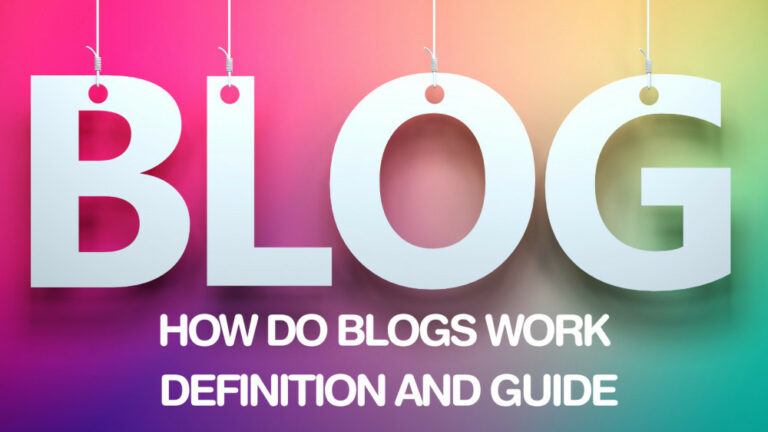What Makes A Good Blog: A Step-by-Step Guide
Blogging is now a very effective tool to connect with people around the world, teach skills, and share ideas. But not all blogs succeed.
Knowing what constitutes a good blog is crucial to producing content that successfully draws in, holds on to, and engages readers.. It speaks directly to its audience, keeps readers interested, and builds trust over time.
In this article, we’ll explore the key elements that make a blog truly effective, helping you create content that resonates and grows your readership.
What Makes A Good Blog: A Step-by-Step Guide
Step 1: Know Your Audience
Before writing anything, you must understand your readers deeply. Think about their interests, problems, and goals. What questions do they ask?
What solutions are they searching for? Consider age, location, experience level, and preferences. Observe what content they read, share, and comment on.
You can modify your writing for engagement, relevance, and utility by being aware of your audience. Creating content unthinkingly wastes effort. When readers feel understood, they stay longer, share more, and return.
Always keep your audience in mind while planning, drafting, and publishing. Audience understanding is the foundation of every successful blog.
Key Points
- Identify age, gender, and location precisely
- Research common problems your readers face
- Analyze the content they already enjoy reading
- Use language your audience easily understands
Step 2: Choose A Clear Topic
Selecting the right topic is critical. Focus on something specific that aligns with both your expertise and audience interests. Broad topics can confuse readers and dilute value.
Narrow issues allow you to provide actionable advice and in-depth insight. Always ask yourself if this topic solves a reader’s problem or answers a key question. Trending topics can boost traffic quickly, but evergreen topics provide long-term value.
Create a list of possible concepts, then select the one that most excites you and your target audience. A clear topic keeps your blog focused, relevant, and impactful.
Key Points
- Focus on one idea per post only
- Avoid overly broad, vague topic choices
- Ensure it solves a reader’s problem
- Check trending or evergreen topic relevance.
Step 3: Craft An Engaging Headline
Readers form their first impressions based on your headline. It should grab attention instantly while clearly indicating the content’s value. Use curiosity, urgency, or numbers to entice clicks.
Avoid clickbait—it erodes trust and frustrates readers. Keep it concise, under seventy characters ideally. Include main keywords naturally for SEO benefits.
Test multiple headline options before publishing. A strong headline promises value and encourages sharing. It should spark interest without misleading the reader.
Headlines are critical because even excellent content can be ignored without a compelling introduction. Take time to craft a headline that draws readers effectively.
Key Points
- Include numbers or lists when possible
- Keep the headline under seventy characters maximum
- Use primary keywords naturally in the title
- Make the headline spark curiosity or interest.
Step 4: Write High-Quality Content
Content is the heart of your blog. Make it informative, conversational, and easy to read. Break long paragraphs into smaller sections. Use examples, stories, or data to clarify points.
Avoid jargon that might confuse readers. Keep sentences short for better flow and readability. Include actionable advice wherever possible.
Readers appreciate content that teaches or solves a problem. Scan your post to ensure smooth transitions between ideas.
Quality content encourages readers to stay longer, share, and return for more. Focus on value, clarity, and engagement, ensuring every sentence serves a purpose and informs your audience.
Key Points
- Use simple language and short sentences
- Include examples, stories, or relevant data
- Add subheadings for easy content scanning
- Avoid fluff or repetitive content sections.
Step 5: Use Visuals
Using relevant and well-optimized visuals is one of the key factors in understanding what makes a good blog. Images, infographics, charts, or videos break up long text and illustrate key points.
Relevant visuals capture attention, improve comprehension, and encourage sharing. Optimize visuals to maintain fast page loading. Use descriptive alt text for accessibility and SEO.
Screenshots or diagrams help explain tutorials or complex ideas. Avoid generic or irrelevant visuals—they distract readers. Combining text with visuals enhances storytelling and keeps readers engaged.
Properly chosen images create a professional, polished look. Always ensure visuals support your content rather than simply decorating the page.
Key Points
- Use relevant images or charts for clarity
- Optimize visuals to reduce loading time
- Include alt text for better accessibility
- Add screenshots for tutorials or examples
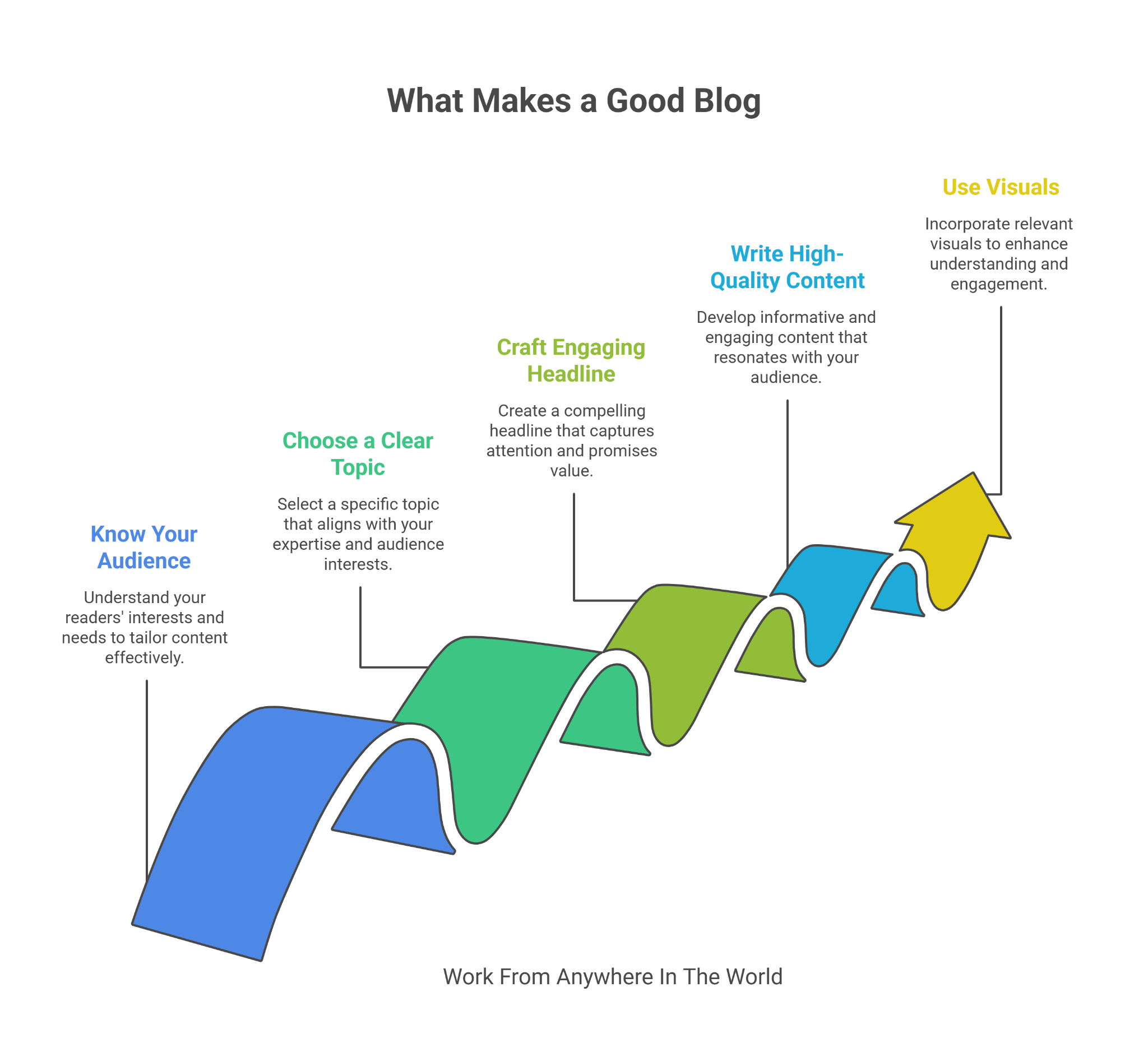
Step 6: Optimize For SEO
SEO ensures your blog reaches the right audience. Use keywords naturally in titles, headings, and content. Include meta descriptions and internal links to strengthen search visibility.
Optimize images with descriptive alt text. Information should be arranged using headings and subheadings for ease of reading. Avoid keyword stuffing, which reduces clarity and search credibility.
Focus on providing real value while remaining search-friendly. Track keyword performance and make necessary strategy adjustments. SEO is a long-term effort, improving traffic steadily over time.
Well-optimized blogs appear higher in search results, attract the right readers, and grow steadily. Consistency in SEO practices is essential.
Key Points
- Include keywords in the title and headings
- Write meta descriptions for better search results
- Link to internal and external resources
- Optimize images using descriptive alt tags
Step 7: Edit And Proofread
Editing is essential for credibility. Even excellent content loses impact if it is full of errors. Read aloud to catch awkward sentences or mistakes.
Check grammar, spelling, punctuation, and formatting thoroughly. Ensure tone and style remain consistent throughout. Remove unnecessary words or repetitions that confuse readers.
Polished content improves readability and keeps your audience engaged. Consider using grammar tools or asking someone to review your post. Take time before publishing.
A carefully edited blog reflects professionalism, builds trust, and ensures your message comes across clearly. Editing turns good content into great, shareable content.
Key Points
- Read aloud to catch awkward sentences
- Use grammar tools for error checking
- Ensure tone and style remain consistent
- Remove unnecessary words or repeated points.
Step 8: Promote Your Blog
Promotion ensures your content reaches a broad audience. Share posts on social media platforms, relevant communities, and forums. Urge people to forward this to their friends and followers.
Consistent and strategic promotion is an integral part of what makes a good blog and helps it reach more readers effectively. Use email newsletters to drive traffic and keep subscribers informed.
Paid advertising can supplement organic reach when appropriate. Timing matters—post when your audience is most active. Consistent promotion increases visibility, engagement, and long-term growth.
Don’t rely solely on search engines; proactive sharing ensures your hard work reaches the right audience. Promotion amplifies your blog’s impact and value consistently.
Key Points
- Share across multiple social media platforms
- Collaborate with influencers or other bloggers
- Encourage readers to share posts widely
- Use email newsletters to increase traffic
Wealthy Affiliate – Mini Review (2025)
If you’ve ever thought about turning your blog, passion, or niche into an online business,
Wealthy Affiliate (WA) is one of the most beginner-friendly platforms I’ve used.
It combines step-by-step training, website hosting, SEO research tools,
and an active community all in one place.
What I like most: you can start free (no credit card needed),
explore lessons, test the tools, and connect with other entrepreneurs
before upgrading. WA isn’t a “get rich quick” scheme — it’s a platform where success comes
from consistent effort and applying what you learn.
Step 9: Encourage Engagement
Engagement creates a loyal and interactive audience. Invite readers to comment, ask questions, or share their opinions. Respond promptly to comments to build relationships. Use polls, surveys, or discussion prompts to spark interaction.
Social media discussions extend engagement beyond the blog. Engaged readers are more likely to return and recommend your blog to others.
Highlight top comments or incorporate feedback in future posts. Engagement also helps you understand what topics resonate most.
Creating a community around your blog builds trust, loyalty, and long-term readership. Always encourage interaction while genuinely valuing reader contributions.
Key Points
- Ask open-ended questions to prompt discussion
- Respond to comments quickly and thoughtfully
- Use polls or surveys for audience feedback
- Encourage social media conversations around posts
Step 10: Add A Call-To-Action (CTA)
Having clear and well-placed calls to action is a vital part of what makes a good blog that drives reader engagement and results.
Whether it’s subscribing, sharing, or purchasing, a CTA provides direction. Place them strategically above, within, or below content.
Use concise, action-oriented words such as “Download,” “Subscribe,” or “Learn More.” Test different CTA styles for better effectiveness.
Avoid overwhelming readers with too many CTAs. Make them feel natural and relevant. Highlight benefits to encourage clicks. A strong CTA converts passive readers into active participants.
Align CTAs with blog objectives to maximize results. Every post should have a clear, actionable CTA that encourages meaningful reader action.
Key Points
- Place the CTA clearly above or below the content
- Use short action-oriented words in CTA
- Keep CTA concise and easy to follow
- Test different styles to find the best results.
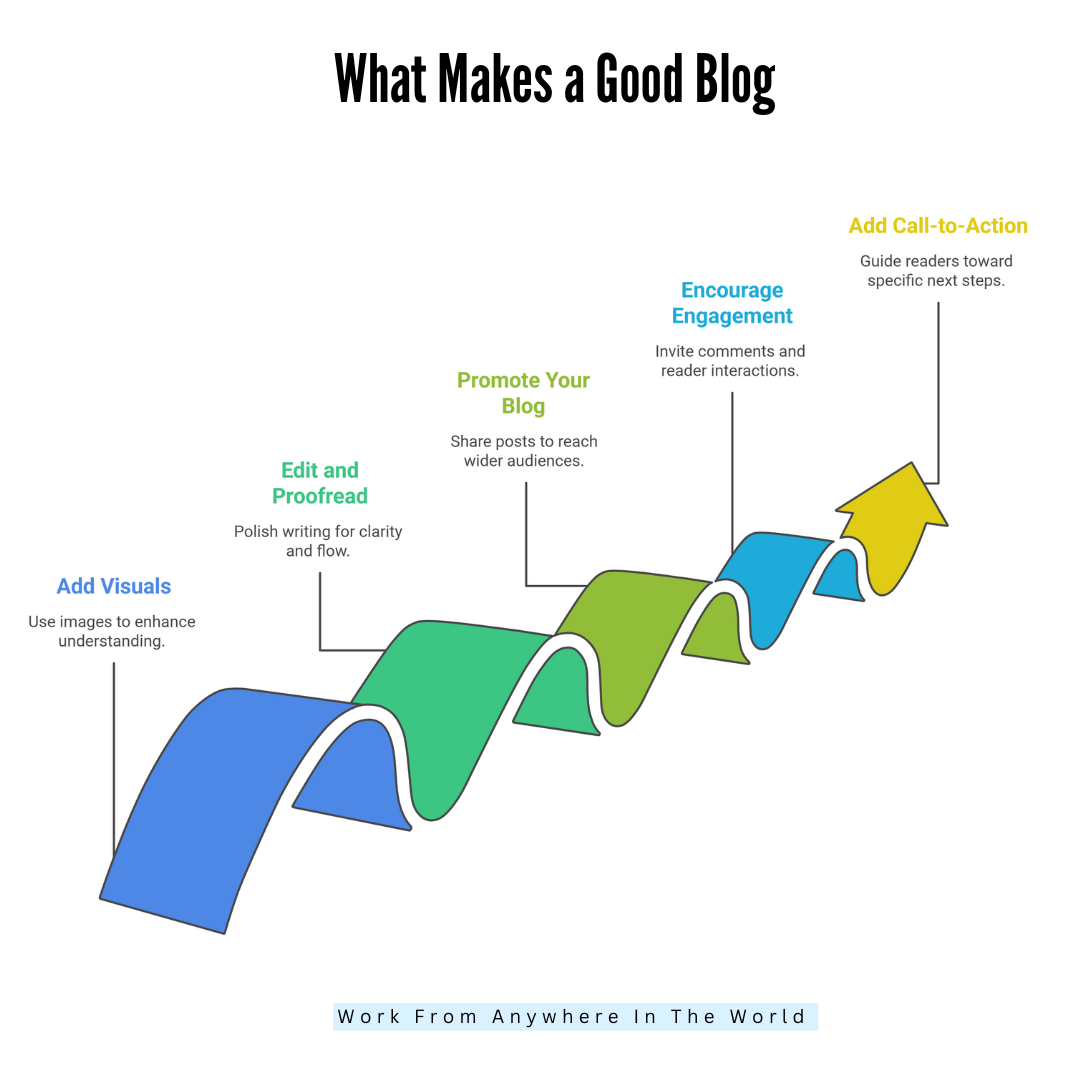
Step 11: Monitor Analytics
Tracking your blog’s performance is essential for improvement—track data like page visits, time on page, shares, and bounce rates.
To learn more, use resources like Google Analytics. Identify which posts perform best and what content engages readers most.
Analytics reveal audience demographics and behaviour patterns. Adapt your content strategy in light of data-driven discoveries.
Regular monitoring helps you spot weaknesses, optimize posts, and improve traffic. Analytics also guide SEO and promotion decisions.
Understanding performance ensures you invest time effectively. Monitoring metrics is a continuous process that helps your blog grow strategically and sustainably.
Key Points
- Check page views and time spent metrics
- Monitor bounce rates for possible improvements
- Analyze posts with the highest shares and engagement
- Use analytics tools like Google Analytics
Step 12: Update Content Regularly
Keeping content fresh improves SEO and reader retention. Regularly updating and refreshing content is a key part of what makes a good blog that stays relevant and trustworthy. Refresh outdated links or examples to maintain accuracy.
Repurpose popular posts into new formats such as videos or infographics. Frequent updates demonstrate the authority, dependability, and activity of your blog. Schedule review dates for all content periodically.
Updated blogs continue generating traffic and engagement over time. Readers trust blogs that stay relevant. Consistent content updates ensure long-term value.
Never ignore older posts—they often remain your most valuable assets when refreshed properly and strategically for readers and search engines.
Key Points
- Refresh statistics and external links regularly
- Add new examples or updated insights
- Repurpose popular posts into fresh formats
- Schedule periodic review of older content
Step 13: Build Your Email List
Email marketing increases engagement, loyalty, and traffic. Provide free tools, checklists, or guides as inducements to promote subscriptions. Embed forms within your blog or use pop-ups thoughtfully.
Send regular newsletters packed with value to maintain reader interest. Personalize emails to increase engagement and click-throughs.
Avoid spamming subscribers; focus on quality over quantity. Emails provide direct access to your audience. Announce new posts, products, or promotions through email campaigns.
A strong email list ensures consistent readership and long-term relationships. Building trust and a responsive subscriber base requires offering value.
Key Points
- Offer free guides or resources for subscribers
- Use embedded forms or pop-ups to capture emails
- Send regular newsletters with valuable content
- Personalize emails for higher engagement rates
Step 14: Network With Other Bloggers
Networking strengthens your blog’s reach, credibility, and authority. Connect with bloggers in your niche through social media, forums, and communities. Guest post on relevant blogs or collaborate on interviews.
Share other bloggers’ content strategically to build relationships. Networking opens opportunities for backlinks, partnerships, and broader exposure.
Engaging genuinely creates mutual benefits, not just promotion. Stay informed about trends and popular topics through peers. Networking also increases your visibility and professional connections.
A strong blogging network amplifies your voice and establishes trust in your niche. Collaboration makes blogging more rewarding, sustainable, and impactful long-term.
Key Points
- Connect with bloggers on social media platforms
- Guest post on other blogs for exposure
- Interview experts in your niche consistently
- Share others’ content strategically for growth.
Step 15: Optimize Page Speed
Page speed has an impact on SEO and user experience. Slow-loading pages frustrate readers and increase bounce rates. Compress images, use caching plugins, and minimize heavy scripts.
Test your blog with speed tools and fix bottlenecks. Fast pages improve readability and encourage users to stay longer. Mobile optimization is also critical, as most readers access blogs via smartphones.
Every second counts—delays can cost traffic and trust. Consistently monitoring speed ensures your blog remains efficient and user-friendly. Performance optimization complements content quality and improves overall audience satisfaction.
Key Points
- Compress images to reduce file size quickly
- Use caching plugins for faster page loading
- Minimize heavy scripts slowing site performance
- Choose reliable hosting for consistent speed
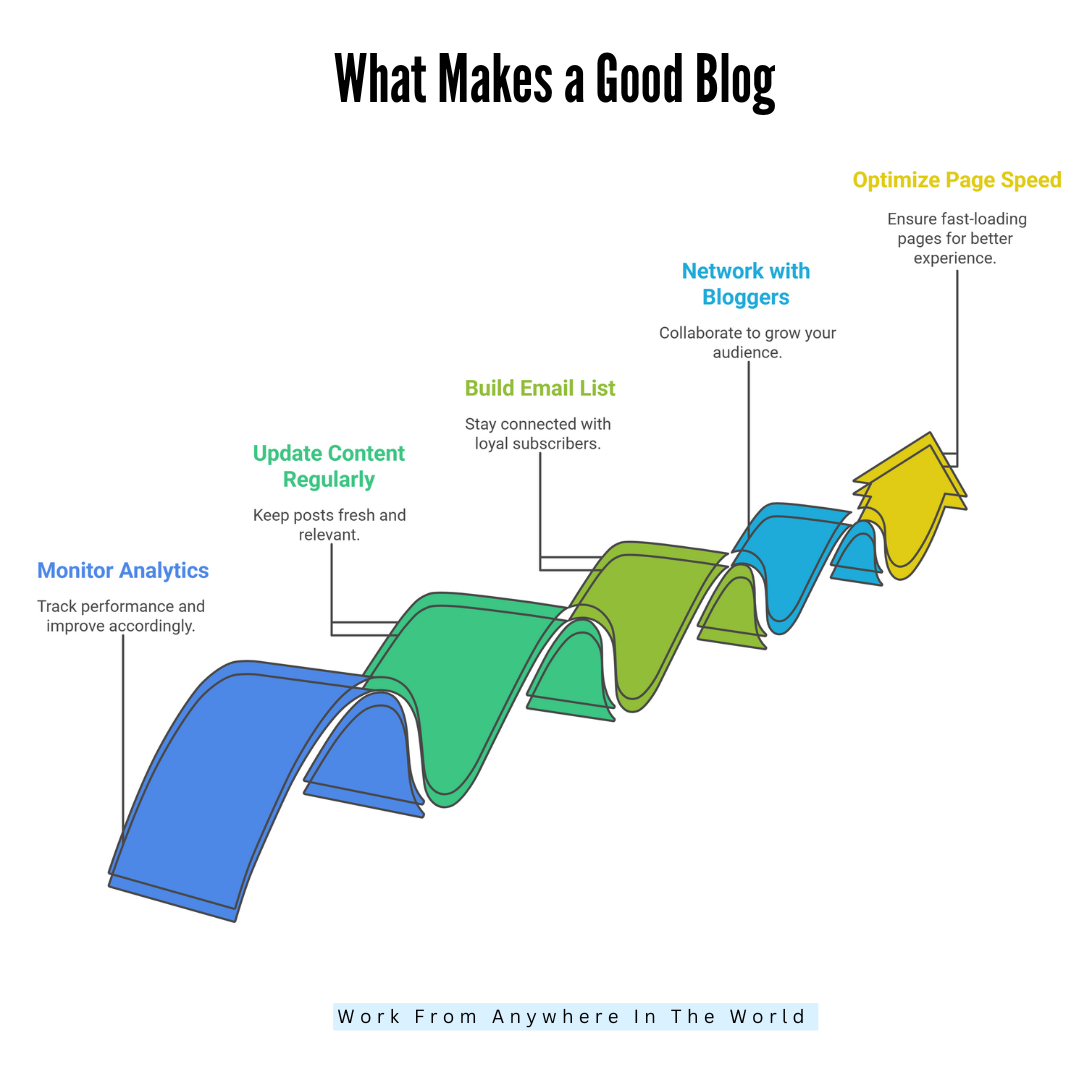
Step 16: Make Your Blog Mobile-Friendly
Most readers access blogs on smartphones or tablets. A responsive design ensures content displays correctly on all screen sizes.
Avoid cluttered layouts, tiny text, or buttons that are hard to tap. Try your site in a variety of browsers and devices. Mobile-friendly blogs rank higher in search engines and improve user experience.
Simplify navigation, use readable fonts, and keep images proportionate. Fast-loading mobile pages keep readers engaged.
Ensuring a seamless mobile experience increases traffic, shares, and repeat visits. Always prioritize mobile usability because a large portion of your audience depends on it daily for content consumption.
Key Points
- Use a responsive design for all screen sizes
- Avoid cluttered layouts on small screens
- Ensure text is readable without zooming
- Test blog on multiple devices regularly
Step 17: Use Internal Linking
Internal links guide readers to related content within your blog. They improve user experience, encourage more extended visits, and reduce bounce rates.
Linking improves SEO by assisting search engines in comprehending the organization of your website. Connect relevant posts naturally in your content. Use descriptive anchor text that tells readers what to expect.
Avoid excessive linking—it can confuse readers. Regularly audit internal links to fix broken or outdated ones. Strategic linking creates a cohesive blog structure.
Internal links help distribute authority across pages, boosting overall search visibility. They also increase page views and encourage deeper engagement with your content.
Key Points
- Link to related posts naturally within content
- Use descriptive anchor text for better clarity
- Avoid overloading pages with too many links
- Audit links regularly to fix broken ones
Step 18: Include External Links
Using credible and relevant external links is an integral part of what makes a good blog that builds trust and authority. They improve trust, authority, and SEO—link to authoritative websites, studies, or statistics relevant to your topic.
Make sure external links on your blog open in a new tab to keep visitors interested. Avoid linking to low-quality or spammy sites. External references show research and build credibility.
They also provide readers with additional resources for deeper learning. Balance internal and external links for better navigation.
Properly used, external links enhance user experience, support claims, and improve search engine trust. Credible referencing strengthens your blog’s reliability and professional image.
Key Points
- Link to authoritative and relevant sources only
- Ensure links open in a new browser tab
- Avoid low-quality or spammy external sites
- Balance internal and external linking strategy
Step 19: Add Social Sharing Buttons
Social sharing icons facilitate instantaneous content sharing for readers. Place them in visible areas like the top, bottom, or sidebars. Encourage readers to share by creating compelling content.
Sharing increases traffic, reach, and blog visibility. Use buttons for major platforms such as Facebook, Twitter, LinkedIn, and Pinterest—test placements to see what works best. Mobile-friendly buttons improve usability.
Highlight share counts to build credibility and encourage more shares. Social sharing integrates your blog into the broader online conversation, driving both traffic and engagement. Make sharing seamless and natural for readers.
Key Points
- Place social buttons in visible blog locations
- Include buttons for major platforms always
- Encourage sharing with engaging content and CTAs
- Optimize buttons for mobile-friendly usability
Step 20: Repurpose Content
The lifespan and reach of content are increased by repurposing. Convert blog entries into social media snippets, podcasts, infographics, or videos. This allows you to reach different audiences and reinforce your message.
Update existing content with new insights and formats. Repurposing saves time while maximizing value from your work. Share repurposed content across multiple channels to attract traffic.
Ensure consistency and relevance in all formats. Repurposed content strengthens your brand presence, reinforces key points, and improves SEO through various formats.
Efficiently using your content across platforms ensures sustained engagement and increases the return on effort invested in blogging.
Key Points
- Convert posts into videos or podcasts
- Create infographics from blog content visually
- Share repurposed content across multiple channels
- Update old posts with new formats or insights
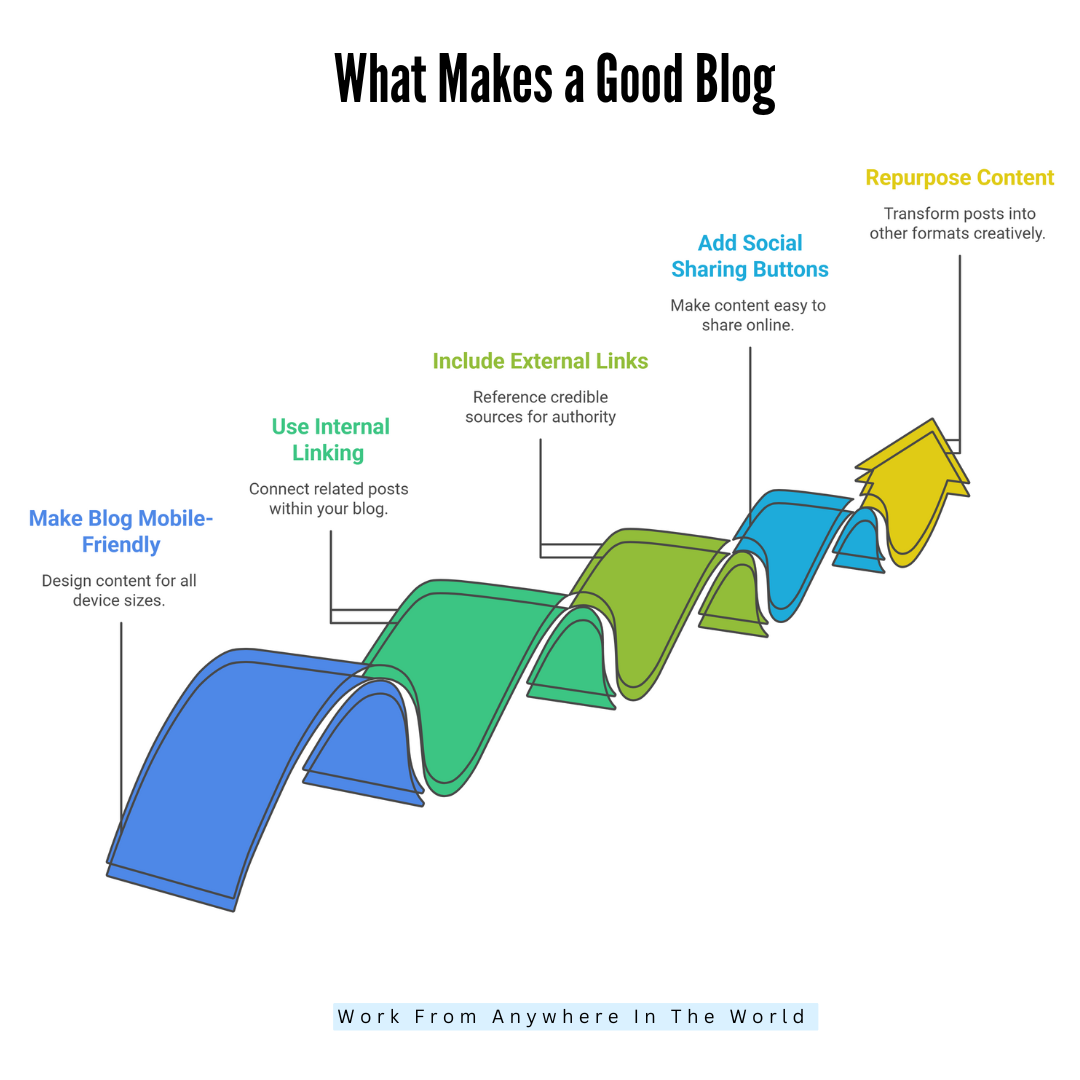
Conclusion
Creating a successful blog requires careful planning, engaging content, and consistent effort. Knowing your audience, choosing clear topics, optimizing for SEO, and promoting posts are essential steps.
Incorporating visuals, encouraging engagement, and updating content regularly strengthen your blog’s impact. Understanding what makes a good blog is the foundation for creating content that inspires readers and achieves lasting success.
Remember, blogging is a journey—patience, persistence, and continuous learning ensure long-term success and a blog that genuinely connects with and serves its audience.
I trust you enjoyed this article on What Makes A Good Blog: A Step-by-Step Guide. Please stay tuned for more insightful blogs on affiliate marketing, online business, and working from anywhere in the world.
Take care!
— JeannetteZ
💬 Your Opinion Is Important To Me
Do you have thoughts, ideas, or questions? I’d love to hear from you. Please leave your comments below or email me directly at Jeannette@WorkFromAnywhereInTheWorld.com.
📚 More Work From Anywhere Reads
🚀 Ready to Build a Business You Can Run from Home
or from Anywhere in the World?
Imagine creating income on your terms — from home, a cozy café, or wherever life takes you.
With the right tools, training, and community support, it’s entirely possible.
Start your own online business for free — no credit card needed.
Disclosure
This post may contain affiliate links. As an Amazon Associate and participant in other affiliate programs, I earn from qualifying purchases at no extra cost to you. Please read my full affiliate disclosure.




